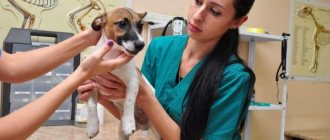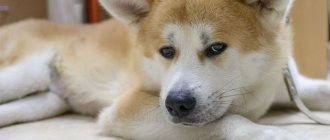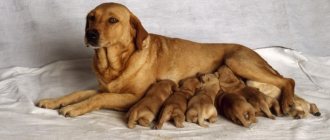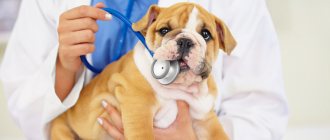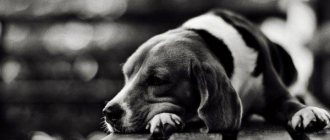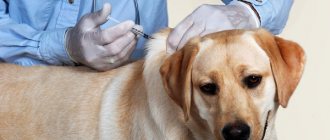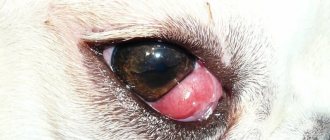Gastric volvulus in a dog is a sharp enlargement and displacement of the stomach, and then its twisting around the esophagus.
The disease is surgical and accounts for up to half a percent of registered cases. Such a low figure does not reflect the full danger of the situation. In the absence of emergency assistance, every sick dog dies within the first six hours. The operation significantly reduces mortality, but repeated cases of gastric volvulus are also observed.
A dog’s stomach is part of the digestive system; it is located in the abdominal cavity, and in anatomical proximity are the lungs and heart, pancreas, liver and spleen, intestines, large blood and lymphatic vessels.
Digestion begins in the oral cavity, where food is subjected to mechanical processing by the teeth and the initial stage of digestion due to saturation with saliva. Next, the food bolus moves through the esophagus into the stomach. At this border there is a ring of muscles or sphincter (Greek sphincter - I squeeze), the same as at the border of the stomach and duodenum, this sphincter is called the pylorus. The task of the sphincter is to prevent the return of the food coma, therefore, after its passage, the muscles contract, which occurs automatically or reflexively, that is, due to an impulse from the nervous system.
In the stomach there are distinguished: the cardiac part - the entry point of the esophagus (from the Greek cardia - heart, since the entrance opening of the stomach is located close to the heart) and the pyloric part - the place where the stomach passes into the duodenum.
The stomach wall is made up of several layers:
- mucous membrane: its cells produce gastric juice, which is involved in digestion;
- muscle layer: it is built from muscle bundles with different directions. Therefore, the volume of the stomach increases when food enters and decreases when it is evacuated. The incoming food lump is gradually saturated with gastric juice, and then begins to move towards the duodenum, from where it goes further into the intestines in the form of a semi-liquid sour gruel;
- The serous membrane is built from connective tissue fibers, which also allow you to change the volume of the stomach.
Gastric volvulus in a dog
Causes of gastric volvulus in dogs
1. Disorders of the dog’s eating behavior and exercise:
- feeding only once a day with excessively large portions immediately before a walk;
- dysphagia or swallowing large amounts of air; as a result of malfunctions of the nervous system, air accumulates and forms a large balloon in the stomach;
- active or sudden movements immediately after feeding, which provoke displacement of the full stomach, up to twisting around the esophagus.
2. Feeds and their components.
The gastrointestinal tract occupies almost the entire abdominal cavity, so one of the defense mechanisms is gases, up to 70% of which are swallowed. So, with each swallow, up to 2-3 ml of air enters the stomach. Normally, a small amount of gas exits through the esophagus in the form of “air burps” or is absorbed in the stomach, or passes into the intestines in “imperceptible” portions.
Some types of foods and feeds contain large amounts of starch, carbohydrates and coarse fiber: cereals (barley, millet, rolled oats), legumes, cabbage, potatoes, pumpkin, black bread; industrially produced feed (depending on the ingredients and manufacturing technology). They contribute to increased gas formation.
3. The development of gastric volvulus in a dog is determined by the anatomy and topography of this organ.
When volume changes, the stomach must maintain its relative mobility. This is possible thanks to the organs to which the stomach is anatomically “attached”: the final part of the esophagus and the initial part of the duodenum, as well as ligaments (bundles of dense fibrous connective tissue) that additionally hold the stomach.
A sharp expansion and torsion of the stomach is usually observed in dogs of large breeds, more than 20-25 kg. It is also necessary to take into account the ratio of the depth and width of the chest (calculated using radiography). If the value is more than 1.4, this is a risk factor.
4. Pathologies of the gastrointestinal tract:
- insufficiency of digestive enzymes (including those contained in gastric juice) disrupts absorption processes in the stomach;
- chronic diseases that affect the ability of the stomach wall to contract, provoke a disruption in the secretion of enzymes, which leads to incomplete breakdown of feed and increased formation of gases;
- tumors of various natures, which can be a mechanical barrier to the removal of gases;
- pathologies of the sphincters: spasm (from the Greek spasmos - spasm) or their prolonged contraction; stenosis (from the Greek stenosis - narrowing); wall thickening. All these changes occur to the sphincter wall due to the growth of connective tissue as a result of its inflammation, scar or injury. Therefore, it is impossible to urgently evacuate the contents of the stomach through vomiting or into the duodenum.
5. Disruption of the nervous system.
The work of the gastrointestinal tract occurs thanks to the neuro-humoral system, which, on the one hand, coordinates, and on the other, instantly responds to any changes in functioning through the release of gastric juice, enzymes and other biologically active substances. Failure at any stage of this relationship leads to disruption of innervation (conduction of nerve impulses) in the wall of the stomach and its sphincters. As a result, the food lump cannot be evacuated in time, which activates the accumulation of gases in the stomach and disrupts the production of gastric juice to continue normal digestion.
6. High altitude conditions
, under the influence of low atmospheric pressure, increased gas formation occurs in the stomach.
7. Stress
of any origin after feeding.
The listed reasons indicate that gastric volvulus can occur in dogs of any breed.
This disease takes time to develop. The starting point is soaking a food coma containing a large amount of starch, carbohydrates and coarse fiber with gastric juice. A significant amount of gaseous substances is released. The stomach increases sharply, the contents put pressure on the wall, it stretches, this disrupts the blood supply and innervation. As a result, a spasm of the sphincters occurs, which “closes” the stomach, further increasing the volume and causing a painful shock.
An overly full stomach begins to shift; the weak point in its fixation is the “loose” ligament with the spleen, which cannot hold such a voluminous and heavy organ. As a result, this entire complex (stomach, spleen and blood vessels) simultaneously rotates around the esophagus. This is very dangerous, because after about four hours, poor circulation leads to necrosis or irreversible death of organ tissue.
Next begins one of the most dangerous stages - compression of nearby organs and vessels, especially the lungs and heart. This is why it is so important to take into account the structural features of the dog’s chest. If it is too narrow, the enlarged stomach simply “presses” the lungs and heart against it. The animal cannot breathe normally and saturate the blood with oxygen, as a result the functioning of the heart and lungs is disrupted. This is also dangerous for the spleen, which increases sharply (up to four times) and accumulates under-oxidized products.
As a result of intoxication, severe changes occur in all internal organs, especially in the nervous system. In combination, this leads to profound changes in the body and the death of the animal.
Prevention of gastric torsion
It is very important to be alert and informed to avoid possible dilation and torsion of a dog's stomach, especially in the summer.
- Always feed your pet after walks;
- do not allow the dog to swallow large amounts of food;
- offer food throughout the day in small portions;
- do not allow your four-legged friend to drink a large amount of water at once after eating;
- limit exercise: do not allow your dog to do a lot of physical activity before and immediately after eating;
- Don't give food before bed.
Share link:
Symptoms of gastric volvulus in dogs
Symptoms may appear within the next hour or two after the onset of the disease:
- a sharp deterioration in the dog’s condition (after simultaneous feeding and physical activity);
- severe anxiety, the dog is looking for a position that could at least temporarily relieve the pain;
- urge to vomit with copious secretion of saliva and mucus, which does not end with emptying of the stomach;
- a rapid increase in the abdominal cavity in volume, the abdomen becomes like a “tight drum”, where when listening (auscultation) increased gas formation is clearly detected, and the sounds of intestinal activity (peristalsis) are absent;
- conjunctiva, mucous membranes of the nasal cavity, oral cavity, external genitalia with a bluish tint - cyanosis or pale, anemic;
- shortness of breath, decreased body temperature;
- the dog has difficulty standing up first on the pelvic and then on the thoracic limbs due to compression of large blood vessels and nerve trunks.
Symptoms of acute dilation and volvulus of the stomach
The twist can be:
- transverse, longitudinal and combined;
- clockwise or counterclockwise;
- parts of the stomach or the entire organ by 90-3600.
- uncomplicated and complicated.
When the exit from the stomach is blocked, food gruel cannot pass into the intestines, and the accumulated gases swell the stomach to enormous sizes. Constriction of large blood vessels leads to ischemia of the spleen, as well as oxygen starvation of the brain and kidneys.
The resulting oxygen free radicals damage tissue, causing intoxication and shock. At the same time, the respiratory movements of the diaphragm become difficult and the blood supply to the heart is inhibited.
The most common variant of volvulus is the transverse cranial-ventral one. Often there is avulsion of the gastrosplenic ligament, damage to the spleen and massive bleeding. With longitudinal volvulus, the stomach rotates around an axis passing through the pylorus and cardia. A significant complication in this case is the separation of the greater omentum along with the vessels feeding the stomach, causing heavy bleeding and necrosis of the stomach wall.
Externally, acute dilatation of the stomach and subsequent torsion usually develops after eating and is manifested by the following symptoms:
- restlessness, severe pain, moaning and whining;
- profuse drooling, licking and unsuccessful urge to vomit;
- a significant increase in the volume of the abdomen behind the ribs due to the stomach being inflated with gases, when tapped, an empty “drum” sound is heard;
- dark red gums at the beginning of the attack, and later - sharply pale and acquiring a bluish tint;
- increasing shortness of breath and tachycardia (pulse up to 100 beats/min).
The animal cannot lie down, moving with a cautious, constrained gait. As the condition worsens, lethargy increases, and the dog freezes doomedly, standing in a hunched position with his head bowed, staggering and heaving his sides heavily. A drop in blood pressure and increasing cardiogenic shock causes an acute disruption of blood circulation and overall homeostasis, leading to oxygen starvation of the brain and fainting. Death occurs within 4-6 hours, and sometimes the dog’s condition worsens as rapidly as a heart attack.
Diagnosis of gastric volvulus
The examination of the dog will begin with the collection of information about the history of life and disease, and a clinical examination.
To establish the stage of the disease, diagnostic studies are necessary:
- X-ray or gastrogram with a contrast agent to accurately understand the picture of the disease;
- ultrasound examination to confirm the diagnosis and accurately determine the location and size of the spleen;
- endoscopy: if the endoscope has passed into the stomach and gastric gases are released, this is an acute dilatation of the stomach; if the esophagus has remained patency, but the stomach has not, this is a gastric volvulus.
Diagnosis, first aid and treatment
If acute dilation and volvulus of the stomach is suspected, the dog should be taken to a veterinary clinic as quickly as possible. A preliminary diagnosis is made through an external examination, and the stage and specifics of each case are determined using special studies, such as:
- radiography of the abdominal organs;
- Abdominal ultrasound:
- endoscopy.
During an x-ray examination, the dog should be in a standing position, since this is the only way to see the fluid levels in the stomach cavity.
Successful insertion of an endoscope into the stomach and rapid release of gases allows not only to confirm the diagnosis of “acute dilatation of the stomach without torsion,” but also to alleviate the dog’s condition. If the endoscopic tube, having passed the esophagus, encounters insurmountable resistance along the way, a conclusion is drawn that a torsion has occurred.
In case of acute dilatation of the stomach, gastric lavage from the contents is indicated, followed by the introduction of substances that stop fermentation. In case of torsion, only an urgent operation performed by a qualified surgeon with experience in this field can save the dog’s life.
However, even with a successful operation, one cannot say with certainty that the trouble is over, since extremely serious complications can lead to the death of the dog within the first 3 days after the operation. So, with a transverse volvulus, you have to cope with massive bleeding and resort to removing the damaged spleen, with a longitudinal volvulus, you have to resection the necrotic part of the stomach, and with a combined volvulus, it creates additional difficulty in returning the stomach to its normal position.
An effective way to reduce the manifestations of cardiopulmonary failure before surgery is puncture or trocar decompression of the stomach.
Some authors recommend resorting to gastric puncture with a thick needle even to the owners themselves in cases where it is not possible to quickly begin the operation. However, this manipulation, if the puncture site is incorrectly chosen, is fraught with a puncture of the spleen and severe internal bleeding, leading to the rapid death of the animal.
Treatment of gastric volvulus in dogs
Gastric volvulus in a dog at any stage of the disease is a threat to life. Treatment can only be prescribed and carried out by a veterinary specialist.
1. In case of acute dilatation of the stomach:
- gastric lavage from contents;
- introduction into the stomach of substances that stop fermentation.
2. For gastric volvulus, only surgical treatment is indicated. During the operation, the stomach is given its anatomically correct position and the contents are removed. To prevent recurrent volvulus, the stomach is sutured in the abdominal wall. If necessary, necrotic tissue is removed. If tissue breaks are found on the spleen, it is removed.
It is important to know: the more time has passed since the onset of the disease, the more serious the consequences, the less favorable the prognosis for the dog.
Symptoms
The first symptoms of gastric volvulus in a dog will be the following:
- the urge to vomit and acute, spasmodic pain, while the animal cannot stand, and when it lies, it holds its hind legs in an extended position, its fingers are tense;
- the stomach swells - this can be felt if the dog feels it;
- the temperature rises sharply up to 40-41 degrees;
- occurs and drooling increases;
- mucous membranes acquire a bluish tint;
- develops .
These symptoms may appear and disappear in a chaotic manner; they are not considered obligatory.
Gastric volvulus in a dog: symptoms that necessarily appear:
- the stomach swells in a matter of minutes to a large size, while it is very hard, the dog suffers from spasmodic attacks of pain;
- no defecation;
- the dog vomits foam;
- weakness and lethargy, turning into collapse;
- septic shock (inflammatory reaction).
If there are at least three of the signs listed above, you should immediately go to a veterinary clinic with a surgical department.
A positive outcome is possible if medical assistance is provided in the first hour after the first signs of gastric volvulus appear. Owners need to remember this well and carefully monitor the condition of their pet.
Prevention of gastric volvulus in dogs using gastropexy
Separately, I would like to highlight the surgical prevention of this pathology, which in Russia, unfortunately, at the moment has not yet received wide enough application, as in European countries.
To do this, it is necessary to do gastropexy - various types of fixation of the position of the stomach. This operation can be performed during routine sterilization of dogs. With the development of endoscopic surgery, it has become possible to perform this operation in a minimally invasive manner, which speeds up the rehabilitation process. By performing this operation in conjunction with laparoscopic sterilization, we obtain maximum prevention of volvulus in dogs and a minimum recovery period. In terms of timing, it differs slightly from the rehabilitation time after laparoscopic sterilization.
Postoperative treatment
Gastric volvulus leads to serious disruptions in the functioning of various organs and systems: heart failure, acute pancreatitis, stomach ulcers, renal failure, and a high probability of developing disseminated intravascular coagulation syndrome. Intensive therapy for such complications should begin during preparation for surgery and continue until the patient recovers completely.
Intensive care medication includes:
- Cardiopulmonary resuscitation drugs (lidocaine, creatine phosphate, etc.).
- Electrolyte and plasma replacement solutions, plasma or whole blood.
- Antiprotease drugs (Gordox, Contrical, Trasylol).
- Drugs that suppress the secretion of pancreatic enzymes and gastric juice (sandostatin, dalargin).
- Agents that improve microcirculation (pentoxifylline, low molecular weight heparins).
- Fat emulsions for deactivation of pancreatic lipase in the blood (lipofundin, lipovenosis).
- Antibiotics.
Depending on the condition of the gastric wall, the animal is prescribed a starvation diet for 1-5 days. If there is no vomiting, you can give the animal something to drink a day after surgery.
Understanding the processes occurring in the body of a dog admitted for gastric volvulus allows us to apply effective treatment methods and prevent the development of life-threatening complications. Modern methods of monitoring the patient’s condition help us create an objective picture of the current state of the heart and respiratory system, quickly respond to changes, and the applied treatment methods help us achieve success in treating patients who until recently seemed hopeless; significantly reduce the rehabilitation period for dogs who have suffered gastric volvulus.
Symptoms of volvulus
Nausea and vomiting with whitish foam may indicate that the dog has a gastric volvulus.
In order to provide timely help to your pet, you need to know the symptoms of the disease. What signs indicate gastric volvulus?
- excessive salivation in the dog and frequent licking;
- nausea, vomiting with whitish foam;
- the stomach becomes swollen and hard;
- the gums turn pale, sometimes acquiring a bluish tint;
- the dog shows anxiety, whines, and may try to dig;
- the back arches, stooping appears;
- the dog does not lie down, is constantly on the move;
- weakness is observed, loss of consciousness is possible.

